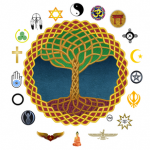Both hands were occupied, one with a piece from a Fisher Price play set while the other clutched a shiny silver baoding ball. The little boy’s attention, however, was on neither as a small stuffed skunk on the floor caught his eye. He stood over the skunk for a moment, then without a second thought, dropped the ball, freeing one hand to pick up the skunk. He looked at it for a moment, then began scanning the room for whatever was next.
Young children are notorious for their short attention spans, but it’s not just young children. It’s all of us. Experiment upon experiment involving adults find that any given experience can only endure in our short-term memory for ten seconds before the brain exhausts its capacity for the present tense. It’s not just young children whose minds ping about, starting a new stream of thought every few seconds. “When we are capable of self-awareness,” writes David Graeber and David Wengrow in their book The Dawn of Everything, “it’s usually for very brief periods of time: the ‘window of consciousness’, during which we can hold a thought or work out a problem, tends to be open on average for roughly seven seconds.”
I’ll bet most of us believe that we’re capable of concentrating on a single subject for longer than that. I sure do, but even during the time it took me to write the previous sentence, I caught my mind flashing away to other matters: I stopped to wipe a bit of lint from my screen, I noticed the shush of traffic outside my windows, I delighted in the coolness of the air coming through my open window, I recalled an errand that I need to run later today, I wondered why my nasal membranes feel so swollen this morning, I warmed myself with a sip of coffee. Each time, I came back to the sentence, but unless I really exerted my will power (a distraction in itself), I was off again.
As a culture we value the ability to concentrate, to focus on our tasks. We tell ourselves that this is the secret to success, that accomplishment, that achieving dreams, that changing the world, begins with blocking out the world in order to focus, focus, focus. We bemoan distractions, blaming them for our failures.

The paradox of attention is that the more we strive to attend, the more difficult it becomes. Sitting down to think about something is probably the worst way to think about it. Indeed, we tend to “think” best when we are in a relaxed, distracted state, in which we are open to the world. That’s why we so often solve our problems while in the shower or on a walk. Indeed, it’s barely in our power to control distractions and maybe that’s how our brains are designed to work: maybe we attend best when we remain receptive to the present moment without feeling that we must somehow fix our minds on a single disconnected problem or challenge. After all, we know that “everything is connected,” so why would we think that we can think more productively by disconnecting?
Of course, there are distractions and then there are distractions. We call our era “the information” age because there is information everywhere, but it would be more accurate to call this “the age of attention” because when information is plentiful, the most valuable commodity is our attention. Social media, for instance, is a notorious time suck, designed to move us along from one thing to the next every 7-10 seconds. This is the kind of distraction that I can usually do without. On the other hand, I have absolutely no resentment toward the small flock of Northern bluebirds that regularly forages in the lawn outside my window. I welcome every text message from our daughter no matter what else I happen to be up to. And does stopping what I’m doing to watch the sunrise even qualify as a distraction? These “good” distractions connect me and my thinking to the real world around me, making it relevant, whereas the distractions offered by those who are buying and selling eyeballs do just the opposite.
Each time I return to the task at hand after a “good” distraction, I do so renewed, refreshed, and with often with exactly the shift in perspective I need to see things more clearly. I imagine that’s how the young boy felt as he flowed from one thing to the next.
The Germans have a wonderful expression — die sell baumelm lassen — that translates as “let the soul dangle.” This suggests to me that our minds are something like our muscles in that in order to grow stronger they need to contract then relax, contract then relax: think, then dangle, think then dangle.
The boy spent his morning going through our classroom, hand-over-hand, from object-of-interest to object-of-interest, limited to one per hand, but always with yet another object in view, his soul dangling, thinking without thinking, open to the world.

This essay originally appeared on the author’s site Teacher Tom.







Love it, Teacher Tom. Teach on! I lit a candle, turned over an hour glass, did 27 pushups and twisted a rotating toy between paragraphs of your essay. My soul dangled.